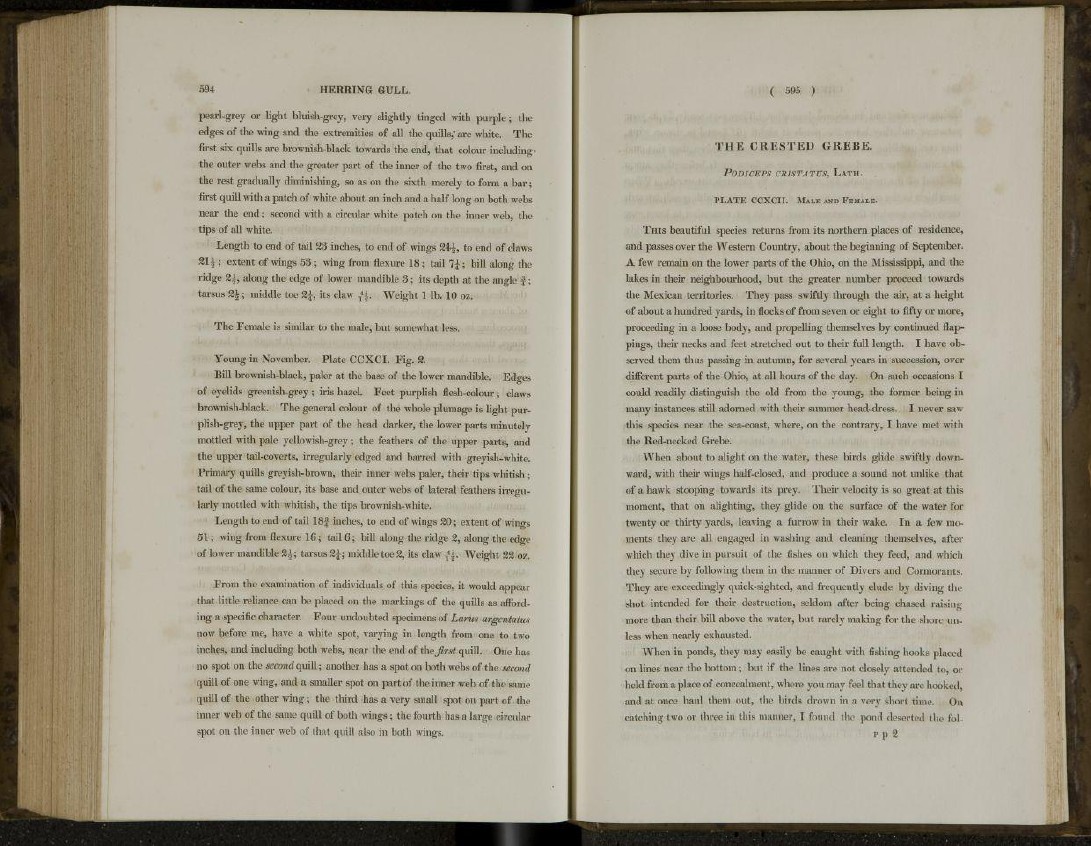
594 HERRING GULL.
pearl-grey or light bluish-grey, very slightly tinged with purple; the
edges of the wing and the extremities of all the quills,' are white. The
first six quills are brownish-black towards the end, that colour including*
the outer webs and the greater part of the inner of the two first, and on
the rest gradually diminishing, so as on the sixth merely to form a bar;
first quill with a patch of white about an inch and a half long on both webs
near the end; second with a circular white patch on the inner web, the
tips of all white.
Length to end of tail 23 inches, to end of wings to end of claws
21^ ; extent of wings 53 ; wing from flexure 18; tail 7£; bill along the
ridge 2;}, along the edge of lower mandible 3 ; its depth at the angle f;
tarsus %\ ; middle toe 2£, its claw ^J. Weight 1 lb. 10 oz.
The Female is similar to the male, but somewhat less.
Young in November. Plate CCXCI. Fig. 2.
Bill brownish-black, paler at the base of the lower mandible. Edges
of eyelids greenish-grey ; iris hazel. Feet purplish flesh-colour; claws
brownish-black. The general colour of the whole plumage is light purplish
grey, the upper part of the head darker, the lower parts minutely
mottled with pale yellowish-grey; the feathers of the upper parts, and
the upper tail-coverts, irregularly edged and barred with greyish-white.
Primary quills greyish-brown, their inner webs paler, their tips whitish;
tail of the same colour, its base and outer webs of lateral feathers irregularly
mottled with whitish, the tips brownish-white.
Length to end of tail 18f inches, to end of wings 20; extent of wings
51; wing from flexure 16; tail 6; bill along the ridge 2, along the edge
of lower mandible 2^; tarsus 2£; middle toe 2, its claw Weight 22 oz.
From the examination of individuals of this species, it would appear
that little reliance can be placed on the markings of the quills as affording
a specific character. Four undoubted specimens of Larus argentatus
now before me, have a white spot, varying in length from one to two
inches, and including both webs, near the end of the first quill. One has
no spot on the second quill; another has a spot on both webs of the second
quill of one wing, and a smaller spot on part of the inner web of the same
quill of the other wing; the third has a very small spot on part of the
inner web of the same quill of both wings; the fourth has a large circular
spot on the inner web of that quill also in both wings.
( 595 )
THE CRESTED GREBE.
PODICEPS CRISTATUS, L A T H.
P L A T E C C X C I I . MALE AND FEMALE.
THIS beautiful species returns from its northern places of residence,
and passes over the Western Country, about the beginning of September.
A few remain on the lower parts of the Ohio, on the Mississippi, and the
lakes in their neighbourhood, but the greater number proceed towards
the Mexican territories. They pass swiftly through the air, at a height
of about a hundred yards, in flocks of from seven or eight to fifty or more,
proceeding in a loose body, and propelling themselves by continued flappings,
their necks and feet stretched out to their full length. I have observed
them thus passing in autumn, for several years in succession, over
different parts of the Ohio, at all hours of the day. On such occasions I
could readily distinguish the old from the young, the former being in
many instances still adorned with their summer head-dress. I never saw
this species near the sea-coast, where, on the contrary, I have met with
the Red-necked Grebe.
When about to alight on the water, these birds glide swiftly downward,
with their wings half-closed, and produce a sound not unlike that
of a hawk stooping towards its prey. Their velocity is so great at this
moment, that on alighting, they glide on the surface of the water for
twenty or thirty yards, leaving a furrow in their wake. In a few moments
they are all engaged in washing and cleaning themselves, after
which they dive in pursuit of the fishes on which they feed, and which
they secure by following them in the manner of Divers and Cormorants.
They are exceedingly quick-sighted, and frequently elude by diving the
shot intended for their destruction, seldom after being chased raising
more than their bill above the water, but rarely making for the shore unless
when nearly exhausted.
When in ponds, they may easily be caught with fishing hooks placed
on lines near the bottom; but if the lines are not closely attended to, or
held from a place of concealment, where you may feel that they are hooked,
and at once haul them out, the birds drown in a very short time. On
catching two or three in this manner, I found the pond deserted the fol-
P p 2